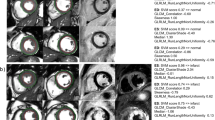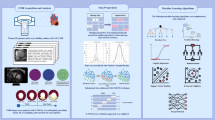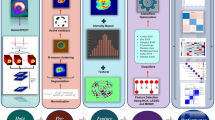Abstract
Purpose
Regional infarction identification is important for heart disease diagnosis and management, and myocardial deformation has been shown to be effective for this purpose. Although tagged and strain-encoded MR images can provide such measurements, they are uncommon in clinical routine. On the contrary, cardiac CT images are more available with lower costs, but they only provide motion of cardiac boundaries and additional constraints are required to obtain the myocardial strains. The goal of this study is to verify the potential of contrast-enhanced CT images on computer-aided regional infarction identification.
Methods
We propose a biomechanical approach combined with machine learning algorithms. A hyperelastic biomechanical model is used with deformable image registration to estimate 3D myocardial strains from CT images. The regional strains and CT image intensities are input to a classifier for regional infarction identification. Cross-validations on ten canine image sequences with artificially induced infarctions were used to study the performances of using different feature combinations and machine learning algorithms.
Results
Radial strain, circumferential strain, first principal strain, and image intensity were shown to be discriminative features. The highest identification accuracy (\(85\pm 14\) %) was achieved when combining radial strain with image intensity. Random forests gave better results than support vector machines on less discriminative features. Random forests also performed better when all strains were used together.
Conclusion
Although CT images cannot directly measure myocardial deformation, with the use of a biomechanical model, the estimated strains can provide promising identification results especially when combined with CT image intensity.











Similar content being viewed by others
References
Thygesen K, Alpert JS, Jaffe AS, Simoons ML, Chaitman BR, White HD (2012) Third universal definition of myocardial infarction. J Am Coll Cardiol 60(16):1581–1598
Mozaffarian D, Benjamin EJ, Go AS, Arnett DK, Blaha MJ, Cushman M, de Ferranti S, Després JP, Fullerton HJ, Howard VJ, Huffman MD, Judd SE, Kissela BM, Lackland DT, Lichtman JH, Lisabeth LD, Liu S, Mackey RH, Matchar DB, McGuire DK, Mohler ER, Moy CS, Muntner P, Mussolino ME, Nasir K, Neumar RW, Nichol G, Palaniappan L, Pandey DK, Reeves MJ, Rodriguez CJ, Sorlie PD, Stein J, Towfighi A, Turan TN, Virani SS, Willey JZ, Woo D, Yeh RW, Turner MB (2015) Heart disease and stroke statistics-2015 update: a report from the American Heart Association. Circulation 131(4):e29–e322
Bax JJ, Schinkel AFL, Boersma E, Rizzello V, Elhendy A, Maat A, Roelandt JRTC, van der Wall EE, Poldermans D (2003) Early versus delayed revascularization in patients with ischemic cardiomyopathy and substantial viability: impact on outcome. Circulation 108(10 suppl 1):II–39–II–42
Pope JH, Aufderheide TP, Ruthazer R, Woolard RH, Feldman JA, Beshansky JR, Griffith JL, Selker HP (2000) Missed diagnoses of acute cardiac ischemia in the emergency department. N Engl J Med 342(16):1163–1170
Marcus JT, Götte MJW, van Rossum AC, Kuijer JPA, Heethaar RM, Axel L, Visser CA (1997) Myocardial function in infarcted and remote regions early after infarction in man: assessment by magnetic resonance tagging and strain analysis. Magn Reson Med 38(5):803–810
Götte MJW, van Rossum AC, Twisk JWR, Kuijer JPA, Marcus JT, Visser CA (2001) Quantification of regional contractile function after infarction: strain analysis superior to wall thickening analysis in discriminating infarct from remote myocardium. J Am Coll Cardiol 37(3):808–817
Wang H, Amini AA (2012) Cardiac motion and deformation recovery from MRI: a review. IEEE Trans Med Imaging 31(2):487–503
Axel L, Montillo A, Kim D (2005) Tagged magnetic resonance imaging of the heart: a survey. Med Image Anal 9(4):376–393
Neizel M, Lossnitzer D, Korosoglou G, Schäufele T, Peykarjou H, Steen H, Ocklenburg C, Giannitsis E, Katus HA, Osman NF (2009) Strain-encoded MRI for evaluation of left ventricular function and transmurality in acute myocardial infarction. Circulation Cardiovasc Imaging 2(2):116–122
Hsiao EM, Rybicki FJ, Steigner M (2010) CT coronary angiography: 256-slice and 320-detector row scanners. Curr Cardiol Rep 12(1):68–75
McCollough CH, Primak AN, Braun N, Kofler J, Yu L, Christner J (2009) Strategies for reducing radiation dose in CT. Radiol Clin North Am 47(1):27–40
Mahnken AH, Bruners P, Katoh M, Wildberger JE, Günther RW, Buecker A (2006) Dynamic multi-section CT imaging in acute myocardial infarction: preliminary animal experience. Eur Radiol 16(3):746–752
Hoit BD (2011) Strain and strain rate echocardiography and coronary artery disease. Circulation Cardiovasc Imaging 4(2):179–190
Sudarshan VK, Ng EYK, Acharya UR, Chou SM, Tan RS, Ghista DN (2015) Computer-aided diagnosis of myocardial infarction using ultrasound images with DWT, GLCM and HOS methods: a comparative study. Comput Biol Med 62:86–93
Qian Z, Liu Q, Metaxas DN, Axel L (2011) Identifying regional cardiac abnormalities from myocardial strains using nontracking-based strain estimation and spatio-temporal tensor analysis. IEEE Trans Med Imaging 30(12):2017–2029
Punithakumar K, Ayed IB, Islam A, Goela A, Ross IG, Chong J, Li S (2013) Regional heart motion abnormality detection: an information theoretic approach. Med Image Anal 17(3):311–324
Wong KCL, Tee M, Chen M, Bluemke DA, Summers RM, Yao J (2015) Computer-aided infarction identification from cardiac CT images: a biomechanical approach with SVM. In: Navab N, Hornegger J, Wells WM, Frangi AF (eds) MICCAI 2015, Part II, Springer International Publishing, LNCS, vol 9350, pp 144–151
Cerqueira MD, Weissman NJ, Dilsizian V, Jacobs AK, Kaul S, Laskey WK, Pennell DJ, Rumberger JA, Ryan T, Verani MS (2002) Standardized myocardial segmentation and nomenclature for tomographic imaging of the heart: a statement for healthcare professionals from the cardiac imaging committee of the Council on Clinical Cardiology of the American Heart Association. Circulation 105(4):539–542
Bathe KJ (1996) Finite element procedures. Prentice Hall, Englewood Cliffs
Toussaint N, Mansi T, Delingette H, Ayache N, Sermesant M (2008) An integrated platform for dynamic cardiac simulation and image processing: application to personalised tetralogy of fallot simulation. In: Proceedings of the first eurographics conference on visual computing for biomedicine, pp 21–28
Fang Q, Boas DA (2009) Tetrahedral mesh generation from volumetric binary and grayscale images. In: IEEE international symposium on biomedical imaging, pp 1142–1145
Pluim JPW, Maintz JBA, Viergever MA (2003) Mutual-information-based registration of medical images: a survey. IEEE Trans Med Imaging 22(8):986–1004
Glass L, Hunter P, McCulloch A (eds) (1991) Theory of heart: biomechanics, biophysics, and nonlinear dynamics of cardiac function. Springer, Berlin
Holzapfel GA (2000) Nonlinear solid mechanics: a continuum approach for engineering. Wiley, London
Wong KCL, Wang L, Zhang H, Liu H, Shi P (2011) Physiological fusion of functional and structural images for cardiac deformation recovery. IEEE Trans Med Imaging 30(4):990–1000
Cortes C, Vapnik V (1995) Support-vector networks. Mach Learn 20(3):273–297
Breiman L (2001) Random forests. Mach Learn 45(1):5–32
Chang CC, Lin CJ (2011) LIBSVM: a library for support vector machines. ACM Trans Intell Syst Technol 2(3):27
Hoffmann U, Millea R, Enzweiler C, Ferencik M, Gulick S, Titus J, Achenbach S, Kwait D, Sosnovik D, Brady TJ (2004) Acute myocardial infarction: contrast-enhanced multi-detector row CT in a porcine model. Radiology 231(3):697–701
Chen YW, Lin CJ (2006) Combining SVMs with various feature selection strategies. In: Guyon I, Nikravesh M, Gunn S, Zadeh LA (eds) Feature extraction, SFSC, vol 207. Springer, Berlin, pp 315–324
Lardo AC, Cordeiro MAS, Silva C, Amado LC, George RT, Saliaris AP, Schuleri KH, Fernandes VR, Zviman M, Nazarian S, Halperin HR, Wu KC, Hare JM, Lima JAC (2006) Contrast-enhanced multidetector computed tomography viability imaging after myocardial infarction: characterization of myocyte death, microvascular obstruction, and chronic scar. Circulation 113(3):394–404
Acknowledgments
This work was funded by the Intramural Research Program of the National Institutes of Health Clinical Center.
Author information
Authors and Affiliations
Corresponding author
Ethics declarations
Conflict of interest
The authors declare that they have no conflict of interest.
Ethical approval
The animal studies were approved by IRB and performed in accordance with ethical standards.
Rights and permissions
About this article
Cite this article
Wong, K.C.L., Tee, M., Chen, M. et al. Regional infarction identification from cardiac CT images: a computer-aided biomechanical approach. Int J CARS 11, 1573–1583 (2016). https://doi.org/10.1007/s11548-016-1404-5
Received:
Accepted:
Published:
Issue Date:
DOI: https://doi.org/10.1007/s11548-016-1404-5




